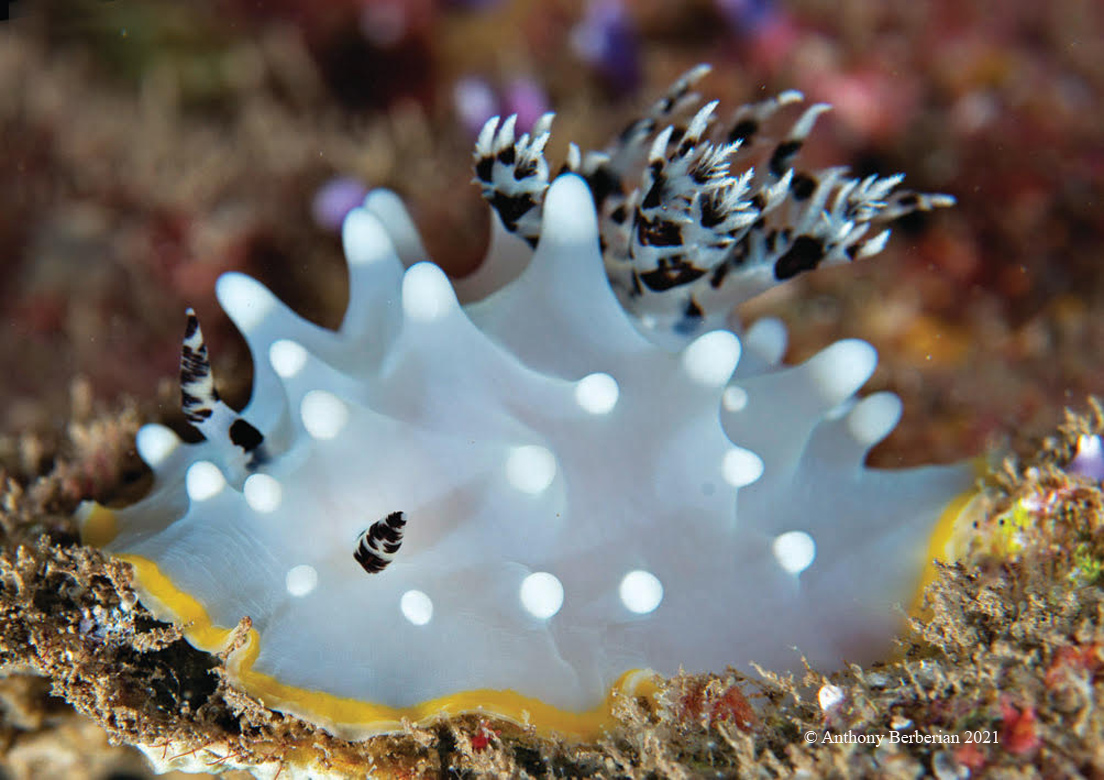 |
Image courtesy of Anthony Berberian
Tahiti
|
Halgerda sp. 5 (in NSSI 2nd Ed) Last week's BOW was a fascinating ecological wonder of a species, who has evolved a long sticky tail to hang onto floating debris. This week we focus on an amazing aposomatic work of art. Anthony discovered this beauty in the waters of French Polynesia. This species bares large tubercles with white tips. It has a yellow-orange marginal band, and black spots of the rhinophores and gills. Halgerda are members of the family Discodorididae, and belong to the group that lack dorsal caryophyllidia, tubercles surrounded by spicules. The bright coloration of this species suggests it has defense chemicals (aka secondary metabolites) used for protection, but little is known about such secretions in Halgerda. I was only able to find two - Zooanemonin and esmodil found in Halgerda aurantomaculata . Seems like a great student project. One of the larger Halgerda species, measuring p to 70 mm in length, it is hard to believe that this species has gone unreported until recently. The only excuse I can think of is no one is diving this area except Anthony. Dave Behrens Sammamish, WA 98074 Jun., 2021 Send Dave email at davidwbehrens@gmail.com |
Dr. Anthony Berberian
 |
Our friend Anthony is a MD, specialized in lab medicine (haematology and immunology), emergency medicine, catastrophe medicine, hyperbaric and diving medicine. Most of his diving centers around Tahiti and the Tuamotu Archipelago, but he has also led expeditions to Papua New Guinea and the Marquesas.
Anthony is a decorated photographer having received "Our World Underwater" - Best of Show in 2015 and Wildlife Photographer of the Year in 2017. Anthony has contributed over three dozen photos of undescribed French Polynesian species to our Nudibranchs and Sea Slugs Identification editions.
Send Anthony email at arava12@yahoo.fr
Sammamish, WA 98074 Jun., 2021 |

Attention all you Sluggers, and you know who you are! The NSSI 2nd edition is now available in ebook PDF and book form . The hard back version will become available Nov. 1st. Both will cost $65 (individually). You will need to jump through a few hoops to get the electronic version as pdf distribution is protected by Adobe ID!! Please read the following to enable reading your electronic purchase! This new 2nd Edition is updated and reorganized, including 185 new species. Among other features, the new edition includes additional photographs of species, an identification key, and an up-to-date classification reflecting the latest evolutionary relationships. The Indo-Pacific represents the largest expanse of tropical ocean in the world, stretching from the Indian Ocean coast of southern Africa and the Red Sea to the central Pacific of the Hawaiian Islands, Easter Island and the Marquesas. This region supports the most diverse marine fauna of any place in the world for most groups of marine organisms. The nudibranchs and sea slugs are no exception to this rule; there are about 3,000 described species of these organisms in the world and at least 40% of these have been found exclusively in the Indo-Pacific tropics. This book illustrates 2,138 Indo-Pacific nudibranchs and sea slugs, including many undescribed species.
|

|
